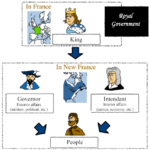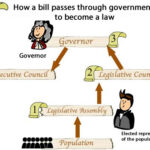In 1820, Lower Canada was one of the colonies of British North America. It had been conquered 60 years earlier and was still the only British colonyColonizationColonization occurs when one country takes control of another country, territory, or people. It happens when... with a French majority.
The colonyColonizationColonization occurs when one country takes control of another country, territory, or people. It happens when... still had to provide raw materials for British manufacturers: grain, timber, fish and furs. In return, Lower Canada received products that were either manufactured in Britain or that came from other British colonies, such as fabrics, metal products, sugar and tea.
 In 1745, at the time of New France, France was the metropolis and there was no parliament in New France. The king of France had absolute power in the colonyColonizationColonization occurs when one country takes control of another country, territory, or people. It happens when....
In 1745, at the time of New France, France was the metropolis and there was no parliament in New France. The king of France had absolute power in the colonyColonizationColonization occurs when one country takes control of another country, territory, or people. It happens when....
In 1820, there was a parliamentary system in Lower Canada which resembled that of Britain. The legislative assembly, which was created in 1791, was the main political institution. However, Britain still had the final say in the administration of the colonyColonizationColonization occurs when one country takes control of another country, territory, or people. It happens when.... Its representative in Canada, the governor, could block any legislation passed by the Legislative Assembly. Some members of the Legislative Assembly were beginning to demand responsible government; that is to say, to have all decisions concerning Lower Canada be made by members who had been elected by the people. (See also The functioning of the parliament)
had the final say in the administration of the colonyColonizationColonization occurs when one country takes control of another country, territory, or people. It happens when.... Its representative in Canada, the governor, could block any legislation passed by the Legislative Assembly. Some members of the Legislative Assembly were beginning to demand responsible government; that is to say, to have all decisions concerning Lower Canada be made by members who had been elected by the people. (See also The functioning of the parliament)
Today
This parliamentary system resembles the one that is still in force today in Québec and Canada, the only exception being that decisions made by its members no longer have to be approved by Britain. There is still a governor-general, but his or her power is purely symbolic.
AuthorAuthor - A person who writes something Auteur - Une personne qui écrit quelque chose: Léon Robichaud; with text updated by the Service national du RÉCIT en univers social
See also
- Traces of the past:







